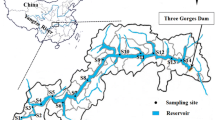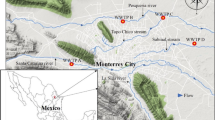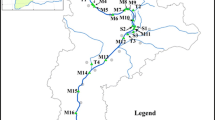Abstract
Liao River Basin (LRB), located in northeast China, is one of seven largest river basins in China. The Daliao River Watershed (DLRW) is severely disturbed by human activities in the LRB. In this study, three rivers within the DLRW—Xi River (XR), Hun River (HR), and Daliao River (DLR)—were selected as sampling locations. The distribution, partitioning, and risk assessment of four endocrine-disrupting compounds (EDCs), e.g., bisphenol A (BPA), 17β-estradiol (E2), estrone (E1), and 17α-ethinyl estradiol (EE2), in the rivers were investigated. The results showed that the concentration of BPA was generally higher than those of the other three steroidal estrogens in the sampling locations. The estrogen levels in the XR were greater than those in the HR and DLR. As a result of a decreasing river flow rate during the frozen season and irregular wastewater discharge from human domestic activities and manufacture processing, the total concentration of selected EDCs in the frozen season was much greater than those in nonfrozen season with the highest concentration in surface water of the XR at 1131.0 ng/L for BPA, 1235.0 ng/L for E1, 1253.5 ng/L for E2, and 17,111.5 ng/L for EE2, respectively. Based on the field-measured BPA concentrations in the sediment and water, the organic carbon-normalized partition coefficient (K oc) of BPA were calculated with the values of 2884–45,031 L/kg; the concentration of BPA in sediment was positive correlated with the content of OC (R 2 = 0.932). The risk assessment made by estradiol equivalent (EEQ) and risk quotient (RQ) showed that 64.7% of sampling sites were exposed to high estrogenic activity (∑EEQ > 1) and high risk in surface water, whereas the RQ values of all selected estrogens in sediment were in medium or minimal risk. Both EE2 and E1 were the major contributors to the total estrogenic activity and risk quotient in surface water.






Similar content being viewed by others
References
AC01769567 (1996) Technical guidance document in support of Commission directive 93 67 EEC on risk assessment for new notified substances and Commission regulation (EC) No. 1488 94 on risk assessment for existing substances. Office for Official Publ. of the European Communities
Arditsoglou A, Voutsa D (2008) Determination of phenolic and steroid endocrine disrupting compounds in environmental matrices. Environ Sci Pollut Res 15:228–236
Arditsoglou A, Voutsa D (2012) Occurrence and partitioning of endocrine-disrupting compounds in the marine environment of Thermaikos Gulf, Northern Aegean Sea, Greece. Mar Pollut Bull 64:2443–2452
Azzouz A, Ballesteros E (2016) Determination of 13 endocrine disrupting chemicals in environmental solid samples using microwave-assisted solvent extraction and continuous solid-phase extraction followed by gas chromatography–mass spectrometry. Anal Bioanal Chem 408:231–241
Bayen S, Zhang H, Desai MM et al (2013) Occurrence and distribution of pharmaceutically active and endocrine disrupting compounds in Singapore’s marine environment: influence of hydrodynamics and physical–chemical properties. Environ Pollut 182:1–8
Casatta N, Mascolo G, Roscioli C, Vigano L (2015) Tracing endocrine disrupting chemicals in a coastal lagoon (Sacca di Goro, Italy): sediment contamination and bioaccumulation in Manila clams. Sci Total Environ 511:214–222
Chang H, Wan Y, Hu J (2009) Determination and source apportionment of five classes of steroid hormones in urban rivers. Environ Sci Technol 43:7691–7698
Diamanti-Kandarakis E, Bourguignon J-P, Giudice LC et al (2009) Endocrine-disrupting chemicals: an endocrine society scientific statement. Endocr Rev 30:293–342
Esteban S, Gorga M, Petrovic M et al (2014) Analysis and occurrence of endocrine-disrupting compounds and estrogenic activity in the surface waters of Central Spain. Sci Total Environ 466–467:939–951
Gibson R, Tyler C, Hill E (2005) Analytical methodology for the identification of estrogenic contaminations in fish bile. J Chromatogr A 1066:33–40
Jiang W, Yan Y, Ma M et al (2012) Assessment of source water contamination by estrogenic disrupting compounds in China. J Environ Sci (China) 24:320–328
Jin HB, Zhu LY (2016) Occurrence and partitioning of bisphenol analogues in water and sediment from Liaohe River Basin and Taihu Lake, China. Water Res 103:343–351
Jin S, Yang F, Xu Y et al (2013) Risk assessment of xenoestrogens in a typical domestic sewage-holding lake in China. Chemosphere 93:892–898
Koyama J, Kitoh A, Nakai M et al (2013) Relative contribution of endocrine-disrupting chemicals to the estrogenic potency of marine sediments of Osaka Bay, Japan. Water Air Soil Pollut 224:1570
Lai K, Johnson K, Scrimshaw M, Lester J (2000) Binding of waterborne steroid estrogens to solid phases in river and estuarine systems. Environ Sci Technol 34:3890–3894
Li Z (2013) Investigation of water pollution status in the Xihe Watershed. Liaoning Chem Ind 6:741–743
Lin C, He M, Liu X, Guo W, Liu S (2013) Distribution and contamination assessment of toxic trace elements in sediment of the Daliao River System, China. Environ Earth Sci 70:3163–3173
Liu YH, Zhang SH, Ji GX et al (2017) Occurrence, distribution and risk assessment of suspected endocrine-disrupting chemicals in surface water and suspended particulate matter of Yangtze River (Nanjing section). Ecotoxicol Environ Saf 135:90–97
Lu GH, Song WT, Wang C, Yan ZH (2010) Assessment of in vivo estrogenic response and the identification of environmental estrogens in the Yangtze River (Nanjing section). Chemosphere 80:982–990
Ma W, Nie C, Chen B et al (2015) Adsorption and biodegradation of three selected endocrine disrupting chemicals in river-based artificial groundwater recharge with reclaimed municipal wastewater. J Environ Sci 31:154–163
Nie M, Yan C, Dong W (2015) Occurrence, distribution and risk assessment of estrogens in surface water, suspended particulate matter, and sediments of the Yangtze Estuary. Chemosphere 127:109–116
Park M, Reckhow D, Lavine M et al (2014) Multivariate analyses for monitoring EDCs and PPCPs in a lake water. Water Environ Res 86:2233–2241
Patrolecco L, Capri S, De Angelis S, Pagnotta R, Polesello S, Valsecchi S (2006) Partition of nonylphenol and related compounds among different aquatic compartments in Tiber River (Central Italy). Water Air Soil Pollut 172:151–166
Pi N, Ng JZ, Kelly BC (2017) Bioaccumulation of pharmaceutically active compounds and endocrine disrupting chemicals in aquatic macrophytes: results of hydroponic experiments with Echinodorus horemanii and Eichhornia crassipes. Sci Total Environ 601:812–820
Prieto A, Vallejo A, Zuloaga O et al (2011) Selective determination of estrogenic compounds in water by microextraction by packed sorbents and a molecularly imprinted polymer coupled with large volume injection-in-port-derivatization gas chromatography–mass spectrometry. Anal Chim Acta 703:41–51
Salgueiro-Gonzalez N, Turnes-Carou I, Besada V et al (2015) Occurrence, distribution and bioaccumulation of endocrine disrupting compounds in water, sediment and biota samples from a European river basin. Sci Total Environ 529:121–130
Shi J, Liu X, Chen Q, Zhang H (2014) Spatial and seasonal distributions of estrogens and bisphenol A in the Yangtze River Estuary and the adjacent East China Sea. Chemosphere 111:336–343
Sun Y, Huang H, Sun Y et al (2013) Ecological risk of estrogenic endocrine disrupting chemicals in sewage plant effluent and reclaimed water. Environ Pollut 180:339–344
Tan L, He M, Men B, Lin C (2009) Distribution and sources of organochlorine pesticides in water and sediments from Daliao River estuary of Liaodong Bay, Bohai Sea (China). Estuar Coast Shelf Sci 84:119–127
Valitalo P, Perkola N, Seiler TB et al (2016) Estrogenic activity in Finnish municipal wastewater effluents. Water Res 88:740–749
Vidaeff AC, Sever LE (2005) In utero exposure to environmental estrogens and male reproductive health: a systematic review of biological and epidemiologic evidence. Reprod Toxicol 20:5–20
Wang L, Ying GG, Zhao JL (2011) Assessing estrogenic activity in surface water and sediment of the Liao River system in northeast China using combined chemical and biological tools. Environ Pollut 159:148–156
Wang G, Ma P, Zhang Q et al (2012a) Endocrine disrupting chemicals in New Orleans surface waters and Mississippi Sound sediments. J Environ Monit 14:1353–1364
Wang L, Ying GG, Chen F et al (2012b) Monitoring of selected estrogenic compounds and estrogenic activity in surface water and sediment of the Yellow River in China using combined chemical and biological tools. Environ Pollut 165:241–249
Wang B, Huang B, Jin W et al (2013) Occurrence, distribution, and sources of six phenolic endocrine disrupting chemicals in the 22 river estuaries around Dianchi Lake in China. Environ Sci Pollut Res 20:3185–3194
Wang Y, Wang Q, Hu L (2015) Occurrence of estrogens in water, sediment and biota and their ecological risk in Northern Taihu Lake in China. Environ Geochem Health 37:147–156
Wu C, Huang X, Lin J, Liu J (2015) Occurrence and fate of selected endocrine-disrupting chemicals in water and sediment from an urban lake. Arch Environ Contam Toxicol 68:225–236
Xu EG, Liu S, Ying GG (2014) The occurrence and ecological risks of endocrine disrupting chemicals in sewage effluents from three different sewage treatment plants, and in natural seawater from a marine reserve of Hong Kong. Mar Pollut Bull 85:352–362
Yang J, Li H, Ran Y, Chan K (2014) Distribution and bioconcentration of endocrine disrupting chemicals in surface water and fish bile of the Pearl River Delta, South China. Chemosphere 107:439–446
Yang L, Cheng Q, Lin L et al (2016) Partitions and vertical profiles of 9 endocrine disrupting chemicals in an estuarine environment: effect of tide, particle size and salinity. Environ Pollut 211:58–66
Ying G-G, Kookana RS (2005) Sorption and degradation of estrogen-like-endocrine disrupting chemicals in soil. Environ Toxicol Chem 24:2640
Ying G-G, Kookana RS, Ru YJ (2002) Occurrence and fate of hormone steroids in the environment. Environ Int 28:545–551
You L, Nguyen VT, Pal A et al (2015) Investigation of pharmaceuticals, personal care products and endocrine disrupting chemicals in a tropical urban catchment and the influence of environmental factors. Sci Total Environ 536:955–963
Yu G, Chen J, Zhang X, Li Z (2013) Comprehensive analysis of an ecological risk assessment of the Daliao River estuary, China. Environ Monit Assess 185:6793–6807
Zhang X, Gao Y, Li Q et al (2011) Estrogenic compounds and estrogenicity in surface water, sediments, and organisms from Yundang Lagoon in Xiamen, China. Arch Environ Contam Toxicol 61:93–100
Zhao JL, Ying GG, Chen F et al (2011) Estrogenic activity profiles and risks in surface waters and sediments of the Pearl River system in South China assessed by chemical analysis and in vitro bioassay. J Environ Monit 13:813–821
Zhao J, Xu ZX, Liu XC, Niu CJ (2013) Source apportionment in the Liao River Basin. China Environ Sci 33(5):838–842
Acknowledgements
This work was supported by the National Natural Science Foundation of China (No. 21277133).
Author information
Authors and Affiliations
Corresponding author
Ethics declarations
Conflict of interest
This manuscript has been seen by all co-authors and its submission has been approved by all co-authors. All the authors declare that there is no conflict of interest.
Rights and permissions
About this article
Cite this article
Tan, R., Liu, R., Li, B. et al. Typical Endocrine Disrupting Compounds in Rivers of Northeast China: Occurrence, Partitioning, and Risk Assessment. Arch Environ Contam Toxicol 75, 213–223 (2018). https://doi.org/10.1007/s00244-017-0482-x
Received:
Accepted:
Published:
Issue Date:
DOI: https://doi.org/10.1007/s00244-017-0482-x




